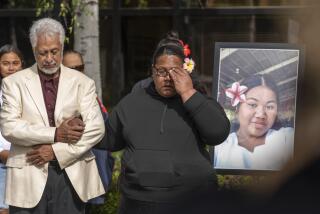Gang Shooting in Westwood
- Share via
On Jan. 30, Karen Toshima was one of thousands of people who went to Westwood Village to have an enjoyable evening. Instead, she found death from a bullet fired by a member of a street gang. In her death, she joined the 60% of victims of gang murders who, like her, were innocent bystanders. Every person who was in Westwood Village on Jan. 30 can truthfully say, “But for the grace of God, it could have been me,” because Karen was not killed by a personal enemy. She was killed by our common enemy, a wantonly violent member of a street gang.
Officers of West Los Angeles area reacted quickly and expertly to her murder. Evidence that would have been destroyed within a few hours was quickly obtained.
On the second day following Karen’s murder a press conference was held at the scene of her death for the primary purpose of appealing to witnesses to come forward. Several percipient witnesses responded to that appeal. The commanding officer of West Los Angeles area announced at the press conference that he intended to deploy more resources in Westwood Village to prevent escalation of gang violence that might be prompted by the shooting. On Feb. 6, Karen’s accused murderer, Durrel Dewitt Collins, was arrested in South-Central Los Angeles. In connection with Collins’ arrest, 23 firearms were seized. Those weapons were removed from the South-Central L.A. community.
Response to this series of events has been extraordinary. Shock and concern over this senseless murder were subordinated by inflammatory bickering over deployment of police officers.
Amazingly, the critics characterized the West Los Angeles area captain’s beefing up of patrol in the area with his own personnel, the media’s coverage of the incident and the suspect’s arrest several days later as evidence of greater LAPD attention to gang murders in Westwood than in the city’s less affluent communities.
No community in the city has an adequate number of police officers. The city’s leadership has belatedly taken note of that fact by recently authorizing additional officers.
The argument that the LAPD is less concerned about violent crimes in non-affluent areas is refuted by facts which suggest the opposite.
A few minutes of research in any local newspaper’s library will produce stacks of articles on violent crimes in the South-Central community, LAPD press conferences on those crimes, and crime suppression efforts by the department. And, if it was in the newspaper, you can bet it was on television.
LAPD press conferences that included appeals for help from the public were instrumental in the swift arrest of a teen-age gang member who shot three children at John Adams Junior High School on Oct. 16. Forty-seven officers worked exclusively on that case.
Media coverage, rapid police response and public assistance resulted in the swift arrest of a juvenile gang member who killed 9-year-old Deandre Brown in a drive-by shooting last June 24.
Those are just two of many examples of media and LAPD attention to violence in South Los Angeles. For the department, those examples reflect the deployment of police officers that by any measure, be it per capita, per square mile, or costs, is higher than in any other part of the city. In addition to regular deployment, over 72% of Metropolitan Division’s deployable officers were assigned to crime task forces in the South-Central community during 1987. In December and January alone, those officers made over 800 arrests, most of which were for gang-related crimes, and they seized over 50 firearms from gang members.
So police efforts and media attention to violent crime are common to all parts of the city. The goal of everyone, police, media, politicians and community leaders should also be a common one: eradicate gang violence from every community in Los Angeles. We can do that if we all work together.
DARYL F. GATES
Police Chief
Los Angeles
More to Read
Sign up for Essential California
The most important California stories and recommendations in your inbox every morning.
You may occasionally receive promotional content from the Los Angeles Times.













